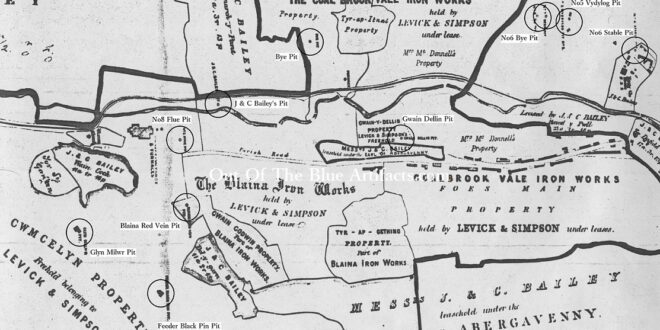J. & C. Bailey land map mid 1800s.
A small portion of a J. & C. Bailey land map mid 1800s showing land leases and just a few of the many collieries.
The map features the collieries circled left to right – Glyn Milwr Pit; The Feeder Black Pin Pit; Blaina Red Vein Pit; No8 Flue Pit; J & C Bailey’s Pit; Bye Pit; Gwain Dellin Pit; No6 Bye Pit; No7 Deep Pit; No5 Vydylog Pit; No6 Stable Pit: The Stable Pit was in the grounds of the Round Houses.
There were many other shafts for Iron and Coal in that particular area over the years.
The following is a list of a few others that were not so well known – The Three-Quarter Pit; Pumping Pit; Patent Pit; Bottle Pit, Blaina No2 Coal Pit; Old Yard Pit; Pump Pit; High Pressure Pit; Flint Colliery; Station Colliery; Garn Colliery; The Tunnel Mine Pit and the Soap Vein Pit:
Even though I have proof these collieries existed, I have no information on their exact location.
Cwmcelyn, Blaina and Coalbrookvale Ironworks works.
The extent of the property and the works were immense. On Wednesday 5th of June 1867, the Cwmcelyn, Blaina and Coalbrookvale Ironworks works were up for sale at auction at the Auction Mart London. The sales sheet read as follows –
The important extensive and valuable Freehold and Leasehold mineral properties known as the Cwmcelyn, Blaina and Coalbrookvale Ironworks works with Collieries, Blast Furnaces, Forge and Rolling Mills with Engineering Works situate in the parish of Aberystruth for sale. The total area is 999a. 1r. 13p (Freehold) 559a. 3r. 9p (Leasehold), 11 seams of Coal with an aggregate thickness of 41 feet, 7 seams of Ironstone extending over the whole area, with several seams of Fire Clay used in the manufacture of Bricks for the works.
The coal is of excellent quality and is for sale for steam purposes and iron making. The iron produced has a good reputation in the market and the brand is well known in Great Britain, The United States, the Continent and the Colonies. The extent and capacity of the works can be judged on the fact that the Forges and Mills have averaged for six years ending 1865 a yearly make of 39,000 tons. From a survey made in December 1865 by Mr John Hedley the eminent mining engineer the quantity of coal un-worked exceeded 30,000,000 tons and 7,300,000 tons of ironstone.
There are 11 pits on the Freehold, from 60 to 210 yards in depth for raising minerals, pumping and ventilation. There are nine pits on the Leasehold from 66 to 220 yards deep used for the same purposes and there are several shafts not in use. The quantity of coal and mine raised on an average of six years have been 304,200 tons annually.
There are 5 blast furnaces – 4 hot blast and 1 cold blast iron with blowing engines, calcining kilns, 114 coke ovens and 2 coal washing machines.
The Forges and Mills are erected on the Freehold and are fitted with 52 puddling furnaces and 2 trains of puddling rolls capable of turning out 900 tons of puddled iron per week. Also 29 balling and re-heating furnaces with 3 trains of rolls for rails, bars, guide rolls etc. There are 2 ranges of benches for straightening, punching and shearing, very spacious and a complete Engineering Works with modern tool including self-acting lathes planing, drilling, slotting, shaping and screwing machines, steam hammer, smiths shop with forges and tools, locomotive sheds, a newly erected Gas Works, a saw mill including steam timber sawing frame, self-acting circular saw benches, band saw etc.
There is also a large Iron Foundry with cranes, air furnace and Cupola Brass Foundry, detached stabling for about 150 horses and complete offices. The works are intersected with a permanent line of railway of the ordinary narrow-gauge width from seven to eight miles in length, besides a very large quantity of small iron tram roads, both above and underground.
The rolling stock and movable plant which will be included in the purchase comprise 6 Locomotive Engines, 138 railway trucks – narrow gauge, 50 trucks of pig iron and metal. 130 furnace cinder carriages. 2,000 iron trams for raising the coal and ironstone, 100 coke and mine barrows and about 70 tons of foundry boxes. 500 pairs of rolls, 350 tons duplicate castings for the forge and mill machinery, travelling cranes and a large assortment of wood patterns.
The water supply is ample as the river Ebbw flows through the property along with several water courses and large reservoirs with connecting pipework to supply the water balance pits and for other purposes.
In addition to the mineral properties and the works described, there are upon the Freehold property upwards of 400 dwelling houses producing a rental of £1,500 per annum and upwards of 500 dwelling houses on the Leasehold property producing a rental of £1,160per annum. There are also 2 shops, houses for principals and agents, schools and chapels.
At Newport there is a commodious Wharf having a river frontage of 235 feet occupying a site of an acre and a quarter with a landing stage erected on piles on the foreshore of the river Usk giving facility for vessels of 600 tons burden to lie and load alongside and with 7 lines of railway running down to the waterside in connection with the Monmouthshire Railway.
 Out Of The Blue Artifacts A Library of a lifetime of collecting
Out Of The Blue Artifacts A Library of a lifetime of collecting
